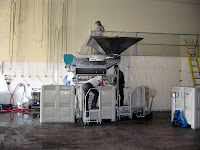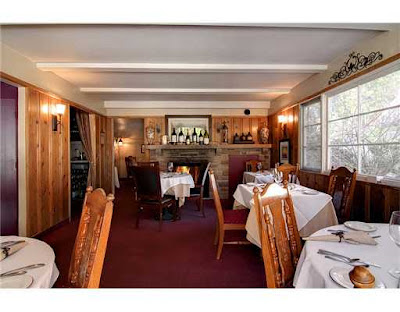I've used the term "Noble Grapes" over the years, but without much explanation of its' use. What is a "noble grape" and why is it important to know about them?
Noble grapes are a term used to describe the international variety of grapes that are most recognizable for the top quality wine they produce. These varieties have principal growing regions, where they are notable for the expression of the local
"terroir", but can be grown in other areas with success. Knowledge of the characteristics of each noble grape variety helps the taster establish a personal relationship with the individual grape and wine. Knowing how it behaves in the vineyard, helps to determine the potential of a vintage (as long as you watch the weather conditions during the growing season).
It is generally accepted (with some argument) that there are only 7 noble grape varieties. For white wines, they are
Chardonnay, Sauvignon Blanc, Riesling. Red wines:
Cabernet Sauvignon,
Pinot Noir,
Merlot, and
Syrah. Funny how they are all French! In France, they are referred to as "cépage noble".
As the new world expands vineyard plantings, we are seeing a growth in experimentation, and the list of grapes is growing. Consumer recognition has grown beyond those original 7 noble varieties. So, I would suggest that the following grapes should be added to that list: Whites: Chenin Blanc, Gewurztraminer, Muscat, Pinot Gris (or Grigio), and Semillon. Reds: Cabernet Franc,
Zinfandel, Gamay, Grenache, Mourvedre Tempranillo, Sangiovese, and
Nebbiolo. That would bring our total to 20 noble grape varieties that consumers recognize around the world, as making top quality wines.
I have discussed some of these grapes in previous articles, and have included links to those blogs. At this point, I will concentrate on the original 7 noble grape varieties, and some of their main characteristics:
Chardonnay:
In the vineyard: Early bloom, early ripening, thin skinned.
In the winery: Takes well to oak aging, easily manipulated. Juice is neutral to apple scented. MLF* common.
Notable regions: Burgundy, Champagne, So America, Australia, California
Wine aromatics: Apple, pear, vanilla fig, pineapple, melon, citrus, lemon, honey, butter
On the palate: Cool climate - zesty with med to high acid, medium body & alcohol. warm climate - low to medium acidity, medium to high alcohol with a "round" or "fat" body.
* MLF refers to
Malolactic Fermentation
Sauvignon Blanc:
In the vineyard: Late budding and early ripening.Challenging to grow, due to tight bunches and tender skins.
In the winery:Usually avoid oak and MLF to emphasize acidity and natural flavors, but California versions (known as Fume Blanc) have oak aging and some MLF.
Notable regions: Loire, Bordeaux, New Zealand, California, Italy, Chile, So. Africa and Canada
Wine aromatics: Distinct vegetal aromas of cut grass, asparagus,or green pepper, plus fruit notes of honeydew, grapefruit, gooseberry, green fig, and lemon or lime. Some also contain a "cat's pee" and mineral scents
On the palate:High acidity, light to medium body, and medium alcohol.
Riesling:
In the vineyard: Early budding and late ripening. Exceptionally hard wood, small compact clusters
In the winery: Stainless steel fermentation to preserve floral and fruit notes. No MLF. Can stop fermentation for sweeter versions, or ferment dry. Tremendous aging potential
Notable regions: Germany, Alsace, Italy, Austria, Australia, United States and Canada.
Wine aromatics: Young-lemon, lime, peach, minerals, beeswax and flowers. Older - gasoline, petrol. Dessert - apricot, honey, raisins, baked apple and peaches.
On the palate: High acid. Can be dry to fully sweet. Low to medium alcohol.
Cabernet Sauvignon:
In the vineyard: Late budding and late ripening.small, thick skinned berries in loose bunches
In the winery: Long maceration period due to high phenolics. Takes well to new oak, works well in blends.
Notable regions: Bordeaux (left bank), Napa CA, Washington, Coonawarra Australia, Italy, Spain, So .Africa, and Chile
Wine aromatics: Cassis (black current) blackberry, black cherry, mint/eucalyptus, green bell pepper. Oak aging can add smoke, toast, tobacco, and vanilla.
On the palate: Dry. Medium to full tannins, acidity, body and alcohol.
Pinot Noir:
In the vineyard: Buds early and ripens early. Thin skinned, and easily mutates. Delicate and demanding
In the winery: Cold soaking is required to extract color and tannins. Very delicate. Used oak barrels.
Notable regions: Burgundy, Champagne, Oregon, California, New Zealand, Chile
Wine aromatics:Cherry, strawberry, plum, raspberry, gamey, leather, mushrooms, "barnyard funk"
On the palate: High acid and juicy. Moderate tannins, bright red fruit character, silky texture.
Merlot:
In the vineyard: Easy to grow. Early budding and early ripening. Large deep colored berries in loose clusters
In the winery:High pigment, but fragile acids. Takes to new oak. In blends, adds suppleness, color, and richness
Notable regions:Bordeaux (left and right bank) Italy, California, Washington, Australia, So Africa, Chile
Wine aromatics:Black fruit, plums, cherries, fig, brown spices (nutmeg & clove), chocolate, coffee, vegetal (if under ripe).
On the palate: Medium acidity and tannins, rich & supple mouth feel
Syrah:
In the vineyard: Late budding and mid ripening (can be fussy). Fairly easy to grow. cold hardy, but prefers warmth.
In the winery: Very versatile. Works with oak or stainless steel. Often blended. Can be made sparkling, still, fortified or rose.
Notable regions: Rhone, Australia (known as Shiraz), Paso Robles CA, Washington.
Wine aromatics: Raspberry, blueberry, blackberry, plum, black currant, violets,carnations, rosemary, tobacco, black pepper, smoke, leather, bacon, chocolate, eucalyptus (particularly in Australia)
On the palate: Brawny to soft. Moderate acidity with medium to high tannins. Full body.
There is some argument that the focus on noble varieties, at the expense of "obscure" local varieties has hurt the wine industry. I tend to agree. If you haven't seen the movie "Mondovino", you should rent it or buy it. It deals with the globalization of wine. If everyone made Cabernet Sauvignon, wouldn't that be boring? When native vines are ripped up and replaced my these noble grapes, there is a loss of the local expression and tradition. Discovery is part of the wine experience. So, enjoy the noble varieties, but continue to explore and enjoy the thousands of other grape varieties out there.




























